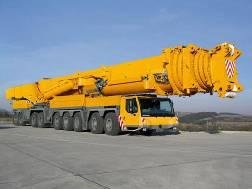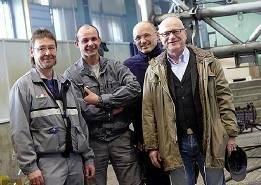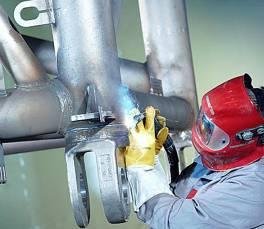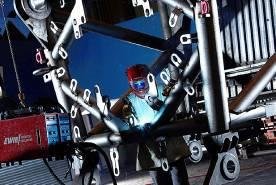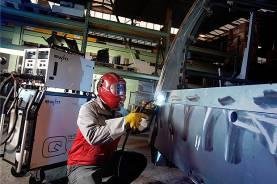Since the company was founded 41 years ago in 1969, it has scaled many heights, successfully negotiated many valleys, and is today an international market leader in mobile and crawler cranes: Well over 20,000 have been delivered to date. In the allterrain cranes market, the company's global share is over 40 percent (Fig. 2).
The Ehingenbased company's recipe for success is "care and quality". Care and quality - the things that make possible the complex yet reliable interplay of mechanical, hydraulic and electronic components, software and tonnes of highstrength finegrained steel. Consequently, the strong focus on quality that always delivers innovation in the form of stateoftheart production processes in production also applies to productivity, and as the company's directors say: "productivity is a science".
For welding the countless plates and pipes used in heavyduty telescopic cranes and crawler cranes, Liebherr has for some time now also been relying on the currently most advanced MAG process forceArc® from Germany's market leader EWM of Mündersbach (Fig. 3). Besides the prerequisite goal to increase process reliability, this investment has - almost surprisingly - resulted in a host of other advantages for the crane constructor.
Tested quality
Just the number of highly qualified fitters and welders certified in accordance with EN ISO 287 illustrates the proportion of the overall production process that is accounted for by thermal joining - 1,230 skilled workers working daily in two shifts are involved in production. So that quality, productivity and progress are continually further developed during the course of the complex work, Liebherr also relies on a healthy blend of experience and curiosity as far as welding supervision is concerned. With great commitment, four people take care of all aspects involved in obtaining the perfect weld seam (Fig. 4). The sole joining process employed in production is metal active gas (MAG) welding, which is done both manually as well as automated with welding robots (Fig. 5). "Every welding seam relevant to the crane's structural stability undergoes an ultrasound and surface crack test as specified in the design drawings", explains welding engineer (IWE) Dipl.-Ing. Reinhard Örtl, head of the welding supervision team (Fig. 6). Normally, this is performed on all supporting structures - whether they're for mobile or crawler cranes, telescopic or lattice booms. Since the process involved in normal MAG welding also means that there is always the possibility of fusion defects, conscientious testing is absolutely essential. If even a minor flaw is discovered, this means that the weld seam must be completely removed. And although this is a factor that's in line with our efforts to achieve safety and quality, it does have a very detrimental effect on productivity".
STS - a welcome presentation
For many years, STS Schweißtechnische Anlagen GmbH of Kornwestheim has been providing valuable consultation services at the Ehingen plant, while equipping it with welding machines and welding accessories, ensuring smooth service and passing on expert knowledge. In mid 2007, shortly after the market introduction of the new MAG process EWM forceArc® in conjunction with the highly dynamic inverter welding power source Phoenix 521 Puls, Wilfried Dohrmann of STS demonstrated the innovation there. forceArc® opened up perspectives for making the MAG process far more reliable and safe compared to conventional welding procedures. As Reinhard Örtl explains: "First of all, my welding supervision colleagues learned about the advantages that forceArc® could give us. The manufacturer promised a particularly directionallystable, concentrated arc with high kinetic pressure for the desired deep fusion penetration and especially good root formation without bonding flaws. These properties are very much in line with our approach to welding - exclusively the stringer bead technique, particularly in our pipe constructions (Fig. 7).
How to increase quality?
Now familiar with forceArc®, Sascha Wilde from our team performed the first welding trials with it in EWM's Westerwald technology centre. And these were Sascha Wilde's observations: "These experiments were convincing from the outset, and shortly afterwards we acquired the first welding system. They then arrived in greater numbers in early 2009. Today, our production division has 15 systems of the type Phoenix 521 forceArc® Puls with twin case", and he goes on to note that "forceArc® brought us the hopedfor and promised process reliability, which makes it far superior to the conventional MAG process". Wilde's assessment of the increase in weld seam quality was "unequivocally - yes".
forceArc® remains on track
Otto Schrode sees yet another advantage of the forceArc® joining process: "There are some seams on components that, despite having a well thoughtout design, are difficult for the welding torch to reach when using the MAG standard process. The powerful arc provided by forceArc® helps us here as well (Fig. 8). It burns with a concentrated arc and always remains on track, even with a very long, free wire end (stickout up to 40 millimetres)." When asked about those whose work is influenced by this innovation, namely the company's welders, Schrode explained that "It goes without saying that our experts were involved in the decisionmaking process. We also proceeded cautiously and in small steps with the introduction. Our staff had been used to the same machines for years, and knew their properties, strengths and weaknesses. And so to ensure a smooth transition to the new welding technology, only a few workstations were initially equipped with Phoenix forceArc®, with welders being trained in the characteristics of the new arc type and its advantages being explained and tested. They too soon discovered how the ideal welding parameters could be reproducibly found without complications, and how easily the machine could be adjusted and controlled - things that were especially important to us when selecting the power source". But the fact that the new welding systems are so easy to service and maintain also delighted those in the workshop, and with that in mind the company's responsible electrician Gerhard Kneer praised the good accessibility of the power unit - from the cooler to the fan, the current sockets to the circuit boards.
Double savings
Besides the special welding properties and the high degree of process reliability that's now been established at Liebherr, the welding supervision team recognises that the EWM systems have dealt them some other impressive trump cards: "The people in Mündersbach supplied us with a type of machine off the shelf that we connected up one to one (plug & play) and set the parameters - and everything worked immediately, everything was in line with our special requirements", recalls Sascha Wilde. "We've never had that from any other manufacturer". Wilde emphasised that "we plugged it in, fitted the wire, connected the shielding gas and started welding straight away".
The fact that real savings can also be made by investing in well thoughtout system solutions came almost as a surprise to the Ehingenbased company: "A second filler material is used for joining the finegrain steel modules. For many years, Liebherr has been using a twin case system so that crackresistant working is possible here. Originally manufactured as the company's own design, the power source manufacturers slowly followed with solutions of varying quality. Wilde emphasises that "EWM offers a system concept that's very difficult to find on the market. With EWMs twin case solution, the Phoenix works with two wire feeds in one casing, each fitted with a different welding wire. The welder takes the appropriate torch and by pressing the torch trigger, our welders can now change conveniently between the various joining tasks in the blink of an eye (Fig. 9). Setup times in comparison to a conventional system are almost completely eliminated". That's a clear endorsement that all members of the team agree with wholeheartedly.
The future is cold
The Ehingenbased joining specialists also feel that they're in capable hands with STS for solving future welding tasks - that's the conclusion to be drawn from the summingup by Dipl.-Ing. Örtl: "Thanks to increasingly sophisticated designs, we can in some cases now use much thinner sheets and pipes for our modules. For some tasks we're already using 4 mm thin sheets - a thickness at which the conventional MAG process applies too much heat. We see the solution as being the MAG variant EWM coldArc® (Fig. 10), which has already won many awards. We are currently comparing and contrasting this innovation for reducedheat "cold" welding with the conventional MAG process. The project is being scientifically underpinned by a thesis at the University of Applied Sciences in Ulm".

